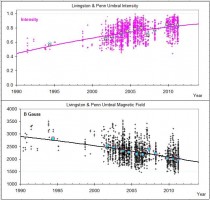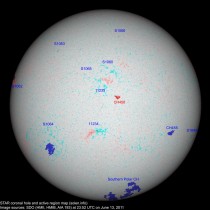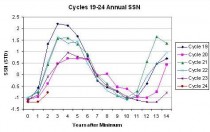Update: Be sure to see James Delingpole’s 10 Reasons to be cheerful about the coming new ice age.
By Anthony Watts, Watts Up With that
It looks like Livingston and Penn are getting some long deserved recognition. See their graph below:
From the WUWT solar reference page. Note: when the B gauss reading of sunspots hits 1500, they will no longer have enough contrast to be visible. That may occur at or near the years 2015-2017.
The American Astronomical Society meeting in Austin has just made a major announcement on the state of the sun. Sunspots may be on the way out and an extended solar minimum may be on the horizon.Fron Space.com reporting from the conference:
Some unusual solar readings, including fading sunspots and weakening magnetic activity near the poles, could be indications that our sun is preparing to be less active in the coming years.
The results of three separate studies seem to show that even as the current sunspot cycle swells toward the solar maximum, the sun could be heading into a more-dormant period, with activity during the next 11-year sunspot cycle greatly reduced or even eliminated.
The results of the new studies were announced today (June 14) at the annual meeting of the solar physics division of the American Astronomical Society, which is being held this week at New Mexico State University in Las Cruces.
Currently, the sun is in the midst of the period designated as Cycle 24 and is ramping up toward the cycle’s period of maximum activity. However, the recent findings indicate that the activity in the next 11-year solar cycle, Cycle 25, could be greatly reduced. In fact, some scientists are questioning whether this drop in activity could lead to a second Maunder Minimum, which was a 70-year period from 1645 to 1715 when the sun showed virtually no sunspots.
“We expected to see the start of the zonal flow for Cycle 25 by now, but we see no sign of it,” Hill said. “This indicates that the start of Cycle 25 may be delayed to 2021 or 2022, or may not happen at all.”
If the models prove accurate and the trends continue, the implications could be far-reaching.
“If we are right, this could be the last solar maximum we’ll see for a few decades,” Hill said. “That would affect everything from space exploration to Earth’s climate.”
More on this as it unfolds.
See also these previous WUWT posts leading up to this on Anthony’s post and the comments here.
See also from Solar Terrestrial Activity Report site, the weak magnetic areas without any strong spots on the sun today. The sunspot number for the day was 16 and the solar flux just 86.6. CHs are coronal holes. No sunspots but often are sources for ionized material to stream well into space.
We are two and one half years after the solar minimum in December 2008. In recent cycles, activity was rapidly approaching the peak three years after the minimum. The last cycle peaked at a sunspot number of 120, about 25% lower than the prior two cycles. Solar flux reached over 200.







